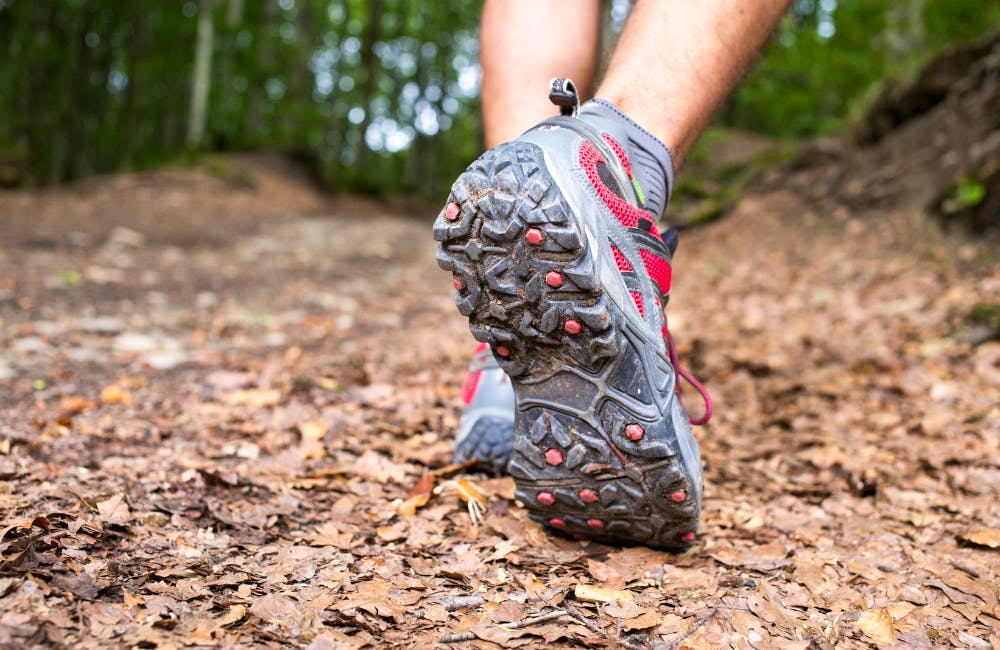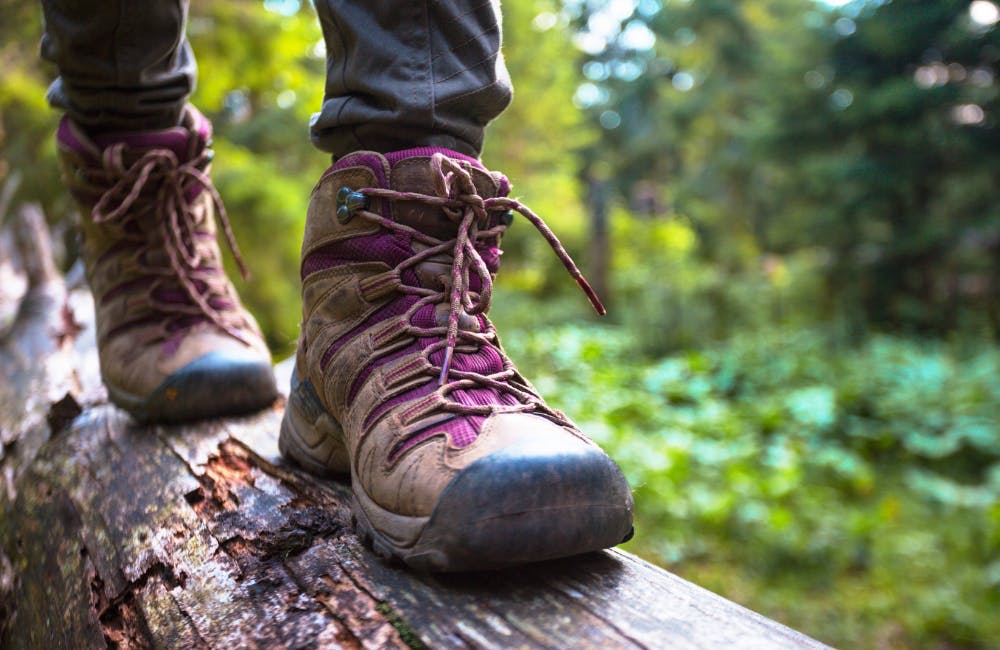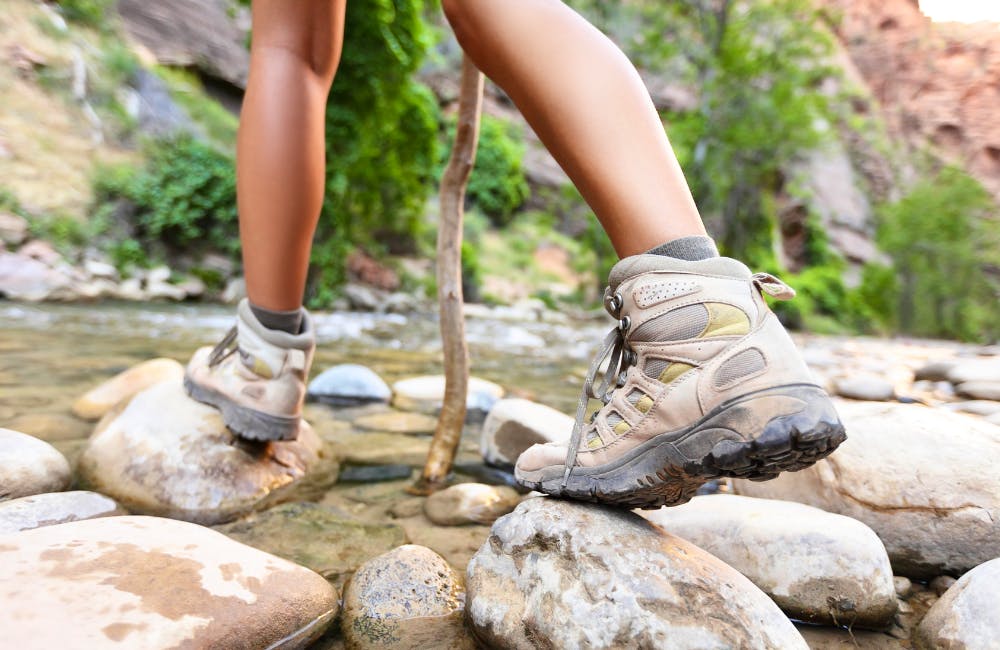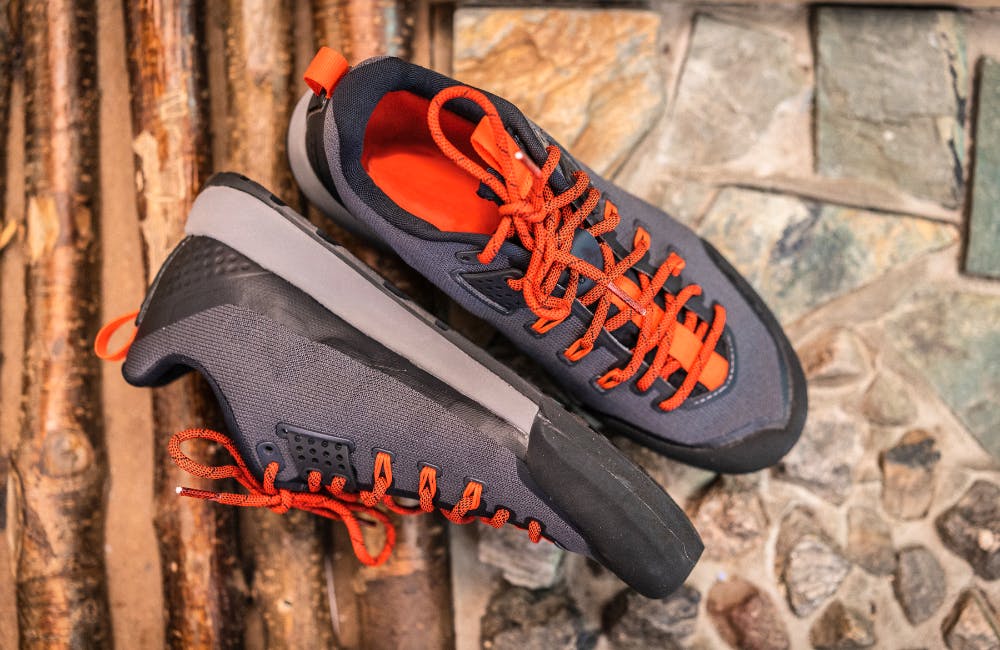Picture this: You're halfway up a stunning trail, taking in the views, when bam! A sudden ache in your foot threatens to ruin your day. All because you picked the wrong shoes. Ouch!
Here at
Skyhook, we've been there. That's why we're discussing the great debate today: hiking shoes vs. boots.
It's not just about looks (though who doesn't want to rock the trails in style?). But your choice can make or break your hike.
So, let's break down the differences for you below.
Hiking shoes (or hiking sneakers) are lightweight, flexible footwear for less demanding trails and day hikes. They're built to offer a balance of comfort, support, and durability without the bulk of traditional boots.
Typically featuring low-cut designs, hiking shoes are crafted with breathable uppers (often synthetic or leather) and sturdy rubber soles with aggressive tread patterns for grip.
They incorporate cushioning midsoles for shock absorption and often include reinforced toe boxes for protection.
Here are a few types of hiking shoes you can consider:
Trail running shoes: These are lightweight and flexible, designed for fast-paced hiking, with good traction and breathability but less protection and support compared to other types.
Low-cut hiking shoes: A step up from trail runners, these provide more protection and support while maintaining flexibility. They're suitable for day hikes and light backpacking on moderate terrain.
Mid-cut hiking shoes: These offer more ankle support than low-cut models but less than full boots. They're a good middle ground if you want extra stability without wearing boots.
Approach shoes: Designed for technical approaches to climbing routes, these shoes combine the features of hiking shoes and climbing shoes. They offer excellent traction on rock and are suitable for scrambling.
Waterproof hiking shoes: Available in various cuts, these shoes feature waterproof membranes like Gore-Tex. They're ideal for wet conditions but may be less breathable in hot weather.
So, if you're planning a short hike (
Torres del Paine day hikes, anyone?) You can get hiking shoes for speed on well-maintained paths.
They're ideal for day trips, light loads, and experienced hikers who prioritise freedom of movement over heavy-duty ankle support.

Latest Deals
Discover trips on sale on Skyhook. Book once-in-a-lifetime adventures at discounted prices.
Hiking boots are sturdy, ankle-high footwear designed for more challenging terrain and longer treks.
They are constructed with durable leather or synthetic materials, with strong, high-top designs that safeguard ankles from twists and impacts. They also often have waterproof membranes for all-weather use.
Their thick, lugged soles provide excellent traction on varied surfaces, while stiff midsoles offer stability and protection against sharp rocks.
Here are a few types of hiking boots:
Lightweight hiking boots: These are versatile for day hikes and weekend backpacking trips. They offer more support and durability than hiking shoes but are lighter than traditional hiking boots.
Midweight backpacking boots: Designed for multi-day backpacking trips, these boots provide excellent support for carrying heavier loads. They're more durable and offer better protection against rough terrain.
Mountaineering boots: These are heavy-duty boots built for challenging alpine conditions. They're incredibly rigid to support crampons and provide insulation for high-altitude, cold-weather hiking and climbing.
Winter hiking boots: Specifically designed for cold weather, these boots offer extra insulation and often feature built-in gaiters to keep out snow.
Full-grain leather boots: If you want durability and water resistance, get full-grain leather boots. They are heavier but offer excellent protection and longevity.
Synthetic boots: Made with materials like nylon and polyester, these boots are typically lighter and more breathable than leather boots but may not be as durable.
You should choose boots for their better support, durability, and protection on rough trails and the best
multi-day hikes in the world - or when carrying heavy loads.
They're ideal for tackling rugged landscapes, crossing streams, and navigating unpredictable mountain conditions.
Key Differences Between Hiking Boots vs. Hiking Shoes
Have you wondered why some hikers strut about in hefty boots while others wear lightweight shoes? Well, it all comes down to what you need on the trail.
Let's break down the key differences so you can decide what's best for your next adventure:
The first way you can tell the difference between hiking sneakers and boots would be construction.
For instance, hiking boots have high-top designs made of durable materials like full-grain leather. They're built to withstand rough terrain and protect your feet.
On the other hand, hiking shoes have low-cut designs with lighter materials, such as synthetic mesh. They're more flexible and suitable for less challenging trails.
2. Ankle Support & Protection
Ever rolled your ankle on a trail? Maybe you were in the wrong shoes for your terrain.
Put simply, hiking boots provide superior ankle support and protection, and their high cuffs reduce the risk of sprains on uneven terrain.
Hiking shoes are not designed to protect you against elements like rocks or mountain debris, so they offer less ankle support to allow for a greater range of motion.
Hiking shoes are significantly lighter than boots, typically weighing 600-850g per pair. This makes them ideal for short day hikes or well-maintained trails where you don't need heavy-duty support.
Hiking boots are heavier, often weighing 900-1300g per pair. This extra weight provides support and protection on challenging terrains or multi-day backpacking trips.
Boots are designed for harsh weather conditions. They often feature waterproof materials and insulation, making them suitable for cold, wet environments.
Hiking shoes offer less protection against extreme weather but are water-resistant enough for mild conditions and shallow stream crossings.
Hiking shoes generally offer better breathability due to their lighter materials and lower cut. This makes them comfortable in warm weather.
While less breathable, boots often incorporate ventilation features to help manage heat during intense activities.
Boots have stiffer soles to provide stability on rough terrain and support when carrying heavy loads. Hiking shoes feature more flexible soles, allowing natural foot movement and a better ground feel on well-maintained trails.
When it comes to longevity, there's a clear difference between boots and shoes.
Hiking boots, with their tougher materials and robust designs, are built to last. They typically outlast hiking shoes, especially in demanding conditions.
Hiking shoes, while not as long-lasting, still offer decent durability. They're usually sufficient for casual hikers and day-trip enthusiasts who stick to less challenging terrain.
Ready to buy hiking footwear? You only need to consider a few key factors:
The type of hiking you'll be doing most often
The terrain you'll encounter
The weather conditions you're likely to face
Your personal comfort preferences
The weight of the pack you'll typically carry
Sturdy hiking boots are usually the best choice for challenging treks like
Everest Base Camp or
Kilimanjaro. They offer the support and protection needed for these demanding terrains and varying weather conditions.
On the other hand, hiking shoes might be sufficient and more comfortable if you're planning a trek on well-maintained paths like parts of the
Tour du Mont Blanc.
For mixed terrain adventures, such as
Aconcagua, where you'll encounter both trails and more technical sections, consider bringing both hiking shoes for the lower portions and sturdy boots for the higher, more challenging areas.
Remember, the best footwear is the one that fits you perfectly and suits your specific hiking needs. Don't hesitate to try on multiple pairs and even test them on short hikes before committing to a longer trek.



















